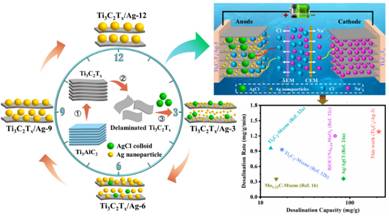Recently, Professor Ma Jie’s group, College of Environmental Science and Engineering of Tongji University, has made new progress in the field of desalination by capacitive deionization. The related results have been published in Advanced Science.

Capacitive deionization (CDI) has attracted attention in the field of desalination, ion separation and recovery widely due to the advantages of high efficiency, easy regeneration and maintenance. In recent years, CDI electrodes have achieved a leap from the electric-double-layer carbon-based materials to faradaic materials, which has greatly enhanced the desalination performance. High-performance electrodes of chloride-ion removal can significantly increase the desalination capacity of CDI, but there are some problems such as low capacity, slow removal rate, side reactions and poor cycling performance.Thus, it has become a top priority that develops a new type of chlorine removal electrode with high capacity and rapid rate simultaneously, which is conducive to promote the further development of CDI technology.

Preparation, electrochemical desalination and mechanism of Ti3C2Tx/Ag electrode
To solve the above problems, Professor Ma Jie’s group proposed a new electrode-design idea based coupling mechanism of battery-type and pseudocapacitive charge storage and developed a new type of Ag/Ti3C2Tx(silver/titanium carbide) electrode for chloride-ion removal with high desalination capacity, rapid rate and low energy consumption. The low-solubility silver chloride colloid as a silver precursor was reduced to silver nanoparticles by Ti3C2Tx, in-situ synthesizing the Ag/Ti3C2Tx electrode. The conversion of silver nanoparticles is responsible for high desalination capacity, while the pseudocapacitive behavior of 2D Ti3C2Tx facilitates ion transport. In addition, the silver nanoparticles are functionalized as “bridges” to vertically connect Ti3C2Tx, a 2D lamellar structure with excellent electrical conductivity, to accelerate the electron transfer between the lamellar layers, building a 3D electron transport network to compensate for the poor conductivity of silver chloride formed during desalination process. The coupling of battery-type and pseudocapacitive charge storage exhibits a high capacity, fast rate and low energy consumption, which provides a new design idea that develops the high-efficiency electrodes for CDI dechlorination. The results were published inAdvanced Sciencewith the title of “Combining Battery-type and Pseudocapacitive Charge Storage in Ag/Ti3C2Tx MXene Electrode for Capturing Chloride Ions with High Capacitance and Fast Ion Transport” and were reported by Materials Views China.
Dr. Liang Mingxing and M.S. Wang Lei (a Ph.D. candidate in the group of Professor Volker Presser of Saarland University, Germany) are the co-first authors. Professor Ma Jie is the corresponding author. Associate Professor Yu Fei (Shanghai Ocean University, China) and Professor Volker Presser (Saarland University, Germany) are the co-corresponding authors. Tongji University is the first affiliation.
Recently, Ma Jie’s group has reported some original research results in the field of removing pollutants from aqueous solution by capacitive deionization, which have been published in international journals (e.g. Advanced Science, Nano Letters, Environmental Science & Technology, Water Research). These researches were funded by the National Natural Science Foundation of China, the Talent Development Fund of Shanghai, the Hundred Talents Program of Tongji University, and the MXene-CDI project of the German Research Foundation.
Literature link: https://doi.org/10.1002/advs.202000621